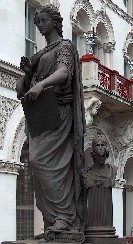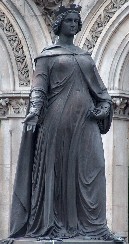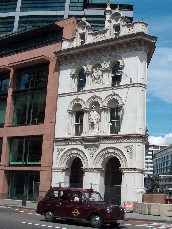

Fine Art and Commerce.
Holborn Viaduct was created to improve the approach to the City of London from the west via the steep-sided Holborn Hill and over the Fleet valley. The viaduct was built in 1860s by the Improvement Committee of the City of London, with the City Surveyor William Heywood as the architect, and took 6 years and over £2 million to complete - a huge cost for the time.
The structure consists of a cast-iron girder bridge with three spans, held up on granite piers, and framed originally by four Renaissance-style houses, of which two survive complete. The interior of the Viaduct also contained a subway for gas, water and telegraph pipes, a passage and a sewer.
The sculptural interest lies in the four bronze larger-than-life sized allegorical figures on the Viaduct, and the two figures and other ornament on the surviving houses. As well, there are bronze winged lions on top, and much in the way of decorative ironwork below.
The four main figures do not line up, as the Viaduct does not cross the road underneath (Farringdon) at right angles. Two of the figures are by Henry Bursill, and made by the celebrated firm of Elkington. They are Commerce, with open hand, money, and the key to the City of London by her feet, and Agriculture, with scythe, corn, and some sort of belt on the floor, perhaps a harness for oxen. Both figures are fairly solid and statuesque. Less so are the two on the other side of the bridge, by Farmer and Brindley, which lack somewhat in nobility, especially in the faces. The first is Science, holding a contraption with two balls that when rotating indicate the speed of a steam engine, and by her side a globe with Zodiacal signs on a pedestal, with a cable leading to a battery. The second statue is Fine Art, unusually but appropriately with drawing sheet and fine pen, to indicate architectural drawing. She stands on the base of a pillar, and the top forms a separate pedestal with a head of Athena to represent sculpture. Where then is an emblem of painting? - dismissed to a pallet and brush lying behind the figure on the floor. Pairs of winged lions at each end of the Viaduct complete the set. (See this page for links to many pages on allegorical sculpture; and several winged lions are shown on the lion sculpture page.)
As noted, there were originally four buildings associated with the Viaduct, reaching down to Farringdon Road underneath, but one is missing, and one is an excellent modern reproduction. These are faced in Portland Stone, and from the upper level we can see carved Neptune heads over the lower arches, and a balcony on each side held up by bearded and scowling male half-figures. Facing the road - best appreciated from the other side - each has a single carved stone statue - Henry Fitz Eylwyn, (Aylwin), first Lord Mayor, and Sir Thomas Gresham - both by Bursill. The modern repro building has a figure of Sir Hugh Myddleton, and the figure on the missing building was of Sir William Walworth. A workman on the repro building when it was being put up in 2000 or 2001 informed me that in due course the fourth corner would be likewise restored after a modern carbuncle had been removed - but no sign of this yet.
Descending to the Farringdon Road, looking at the bridge from a little distance shows the coats of arms to best effect, and on and under the Viaduct is much heraldic work in the way of winged helmets and metal griffins. A walk south from here would take us across one end of Fleet Street, through to Blackfriars Bridge.
 The repro block, with figure of Hugh Myddleton.
The repro block, with figure of Hugh Myddleton.
South to Blackfriars Bridge // East to St Sepulchre, Newgate St // and Old Bailey // West to Prince Albert, Holborn Circus
Visits to this page from 13 Mar 2014: 8,853